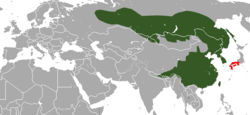| Subspecies | Trinomial authority | Description | Range | Synonyms |
|---|
Siberian kolonok
Mustela sibirica sibirica | Pallas, 1773 | A small subspecies with light, yellowish-red fur. Skull length in males is 5.8–6.3 cm, while in females it is 4.9–5.6 cm. [11] | All of Siberia eastward to the Zeya River basin, the contiguous parts of Mongolia and possibly the extreme western parts of northeastern China | australis (Satunin, 1911)
miles (Barrett-Hamilton, 1904)
|
Tibetan kolonok
Mustela sibirica canigula | Hodgson, 1842 | Distinguished from other subspecies by having a much greater amount of white fur around the muzzle, neck and almost to the forelimbs. It has an exceptionally thick coat and bushy tail. The body is bright foxy-red, and lacks a black tail-tip. [12] | Tibet | |
Manchurian kolonok
Mustela sibirica charbinensis | Lowkashkin, 1935 | | Manchuria | |
Korean kolonok
Mustela sibirica coreanus | Domaniewski, 1926 | | The Korean Peninsula | peninsulae (Kishida, 1931) |
Taiwanese kolonok
Mustela sibirica davidiana  | Milne-Edward's, 1871 | Has a more intense colouration than fontanierii, being almost ochreous orange in fresh winter pelage [13] | Southeastern China north to Hubei and Taiwan | melli (Matschie, 1922)
noctis (Barrett-Hamilton, 1904)
taivana (Thomas, 1913) |
North Chinese kolonok
Mustela sibirica fontanierii  | Milne-Edwards, 1871 | Has a uniform pale fulvous coat with a pale brown forehead and muzzle, with varying degrees of white in the center of the throat and neck [14] | Northern China, including Beijing, Hebei, Shandong, Shaanxi and Shanxi | stegmanni (Matschie, 1907) |
Hodgson's kolonok
Mustela sibirica hodgsoni | Gray, 1843 | Distinguished from canigula by the smaller amount of white on the muzzle, the head's darker hue and the white area of the throat being limited to white patches rather than forming a continuous line. It is similar in size to subhemachalana and moupinensis, though its skull is smaller than the latter's. [15] | Kashmir and the western Himalayas from Kam to Garwal | |
Far Eastern kolonok
Mustela sibirica manchurica | Brass, 1911 | A somewhat larger subspecies than sibirica, with a lighter red coloured coat. Skull length in males is 6.3–6.7 cm, while in females it is 5.7–6.2 cm. [11] | Priamurye to the west of the Zeya, the Primorye and northeastern China | |
Burmese kolonok
Mustela sibirica moupinensis  | Milne-Edwards, 1974 | Closely resembles subhemachalana in having a black tail tip, but distinguished by its larger skull and greater incidence of white fur on the muzzle [16] | Sichuan, Gansu, and Yunnan, China and Burma | hamptoni (Thomas, 1921)
major (Hilzheimer, 1910)
tafeli (Hilzheimer, 1910) |
Quelpart kolonok
Mustela sibirica quelpartis | Thomas, 1908 | | Jeju Island, South Korea | |
Himalayan kolonok
Mustela sibirica subhemachalana | Hodgson, 1837 | Smaller than sibirica and has a blackish tail tip. It lacks the typical white patch on the sides of the muzzle, which is blackish, save for narrow white lines on the edge of the upper lip and a white chin. The general colour ranges from bright foxy-red to dark chocolate brown. [17] | The Himalayas from Nepal to Bhutan | horsfieldii (Gray, 1843)
humeralis (Blyth, 1842)
|
|









